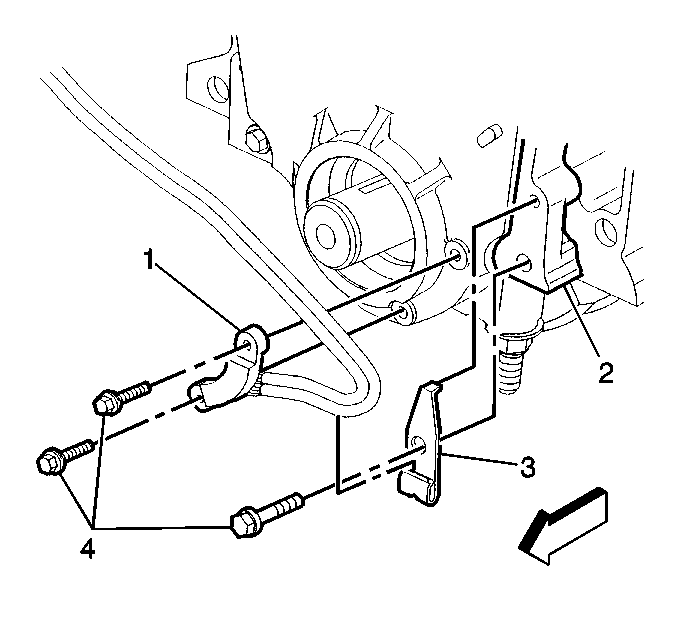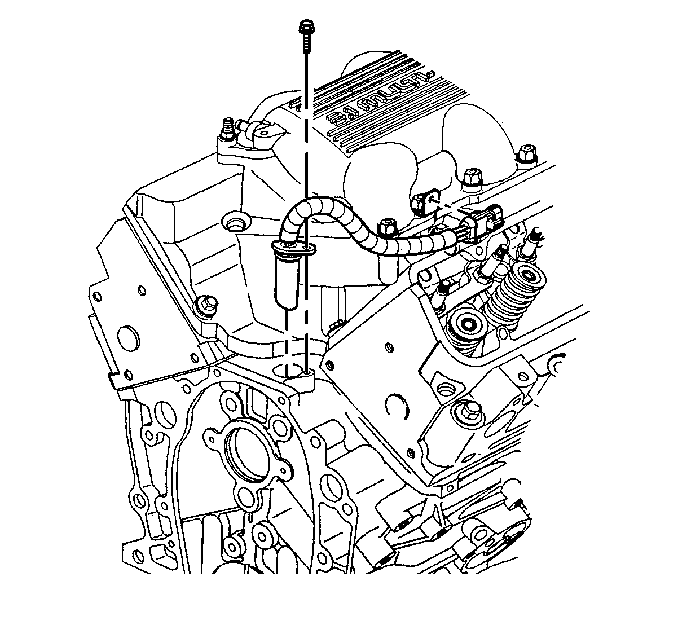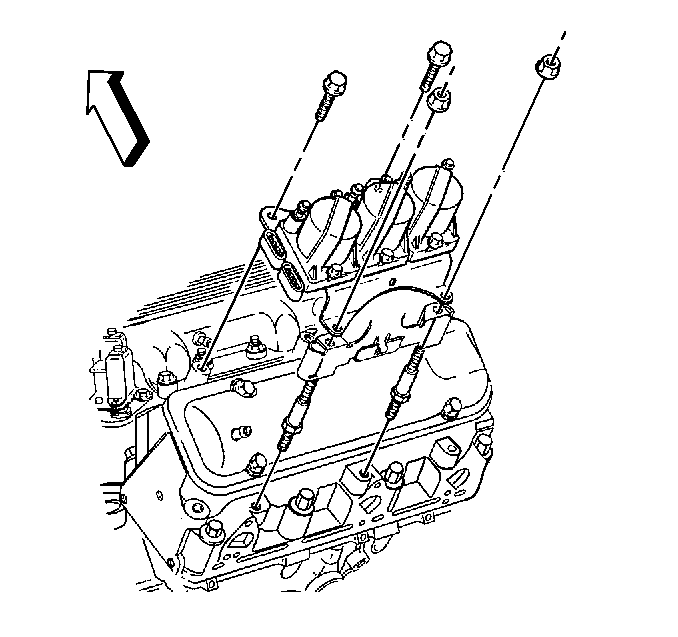The electronic ignition (EI) system consists of the following
components and wiring circuits:
| • | The ignition control (IC) module |
| • | The powertrain control module (PCM) |
| • | The 24X crankshaft position (CKP) sensor |
| • | The camshaft position (CMP) sensor |
The EI wiring circuits listed here use the following service common
names. Between the IC module and the PCM:
| • | Low resolution engine speed signal |
Between the 7X CKP sensor and the IC module:
Between the 24X CKP sensor and the PCM:
| • | Medium resolution engine speed signal |
Between the CMP and the PCM:
The IC module also receives power and chassis ground through the following
circuits:
Purpose
The EI system is responsible for producing and controlling a high energy
secondary spark. This spark is used to ignite the compressed air/fuel mixture
at precisely the correct time to provide optimal performance, fuel economy,
and control of exhaust emissions.
Operation
In this EI system there is one coil for each pair of cylinders. Each
pair is at top dead center (TDC) at the same time, and are known as companion
cylinders. The cylinder that is at TDC the compression stroke is called
the event cylinder. The cylinder that is at TDC of the exhaust stroke
is called the waste cylinder. When the coil is triggered, both plugs fire
at the same time, completing a series circuit. Because the lower pressure
inside the waste cylinder offers very little resistance, the event cylinder
uses most of the available voltage producing a very high energy spark.
This is known as waste spark ignition.
Electronic Ignition (EI) Component Description
The following is a list of ignition system components and their functions.
24X CKP Sensor and Interrupter Ring

The 24X CKP sensor (1),
secured in a mounting bracket (3) and bolted to the front side
of the engine timing chain cover (2), is partially behind the crankshaft
balancer. The crankshaft balancer contains the 24X CKP sensor
interrupter ring.
The 24X CKP sensor contains a hall-effect switch. A hall-effect switch
is a solid state switching device, which produces an OFF/ON pulse when a
rotating element passes between the sensor tip and a magnet. This rotating
element is called an interrupter ring. In this case the interrupter ring
has 24 evenly spaced blades and windows. This sensor produces 24 ON/OFF
signal pulses per crankshaft revolution. The 24X signal is used for enhanced
smoothness and idle stability at a lower calibrated RPM. The 24X signal
is known as the medium resolution engine speed signal.

The 7X CKP sensor is bolted into the center of the engine block and
protrudes into the crankcase. The 7X CKP sensor reluctor wheel is cast into
the crankshaft.
The 7X CKP sensor is a variable reluctance sensor. The magnetic field
of the sensor is altered by a reluctor wheel that has seven machined slots,
six of which are equally spaced 60 degrees apart.
The seventh slot is spaced 10 degrees from one
of the other slots. The 7X CKP sensor produces six pulses and
one sync pulse for each revolution of the crankshaft. This signal must
be present for the ignition control (IC) module to send a 3X reference signal
to the powertrain control module (PCM). The 3X reference is known as the
low resolution engine speed signal.
Camshaft Position (CMP) Sensor

The camshaft position
(CMP) sensor is a hall-effect sensor which is triggered by a magnet pressed
into the camshaft sprocket. The CMP sensor provides a signal pulse once
every camshaft revolution, known as the CMP sensor signal. The IC module
uses this signal to identify the position of the #1 cylinder at top dead
center.
Ignition Coils and Ignition Control Module (ICM)

Three dual tower ignition
coils are mounted to the ignition control module (ICM) , and are serviced
individually. The ICM performs the following functions:
| • | The ICM receives and processes the signals from the 7X CKP sensor. |
| • | The ICM determines the correct coil triggering sequence. This
coil sequencing occurs at start-up, and is remembered by the ICM. After
the engine is running, the module will continue to trigger the coils in
the correct sequence. |
| • | The ICM determines the correct direction of the crankshaft rotation,
and cuts spark and fuel delivery to prevent backfiring if this condition occurs. |
| • | The ICM produces and sends low resolution engine speed signals
to the PCM. |
Powertrain Control (PCM) Module

The PCM is responsible
for maintaining proper spark and fuel injection timing for all driving conditions.
Ignition control (IC) spark timing is the method the PCM uses to control
spark advance and ignition dwell. To provide optimum driveability
and emissions, the PCM monitors input signals from the following
components in calculating (IC spark timing:
| • | The engine coolant temperature (ECT) sensor |
| • | The intake air temperature (IAT) sensor |
| • | The mass air flow (MAF) sensor |
| • | The internal mode or park/neutral position (PNP) inputs from internal
mode switch or Park/Neutral position switch |
| • | The throttle position (TP) sensor |
| • | The vehicle speed sensor (VSS), or transmission output speed sensor
(TOSS) |
The following describes the PCM to IC module circuits:
| • | Low resolution engine speed--PCM input--From the ignition
control module, the PCM uses this signal to calculate engine RPM and crankshaft
position. The PCM also uses the pulses on this circuit to initiate injector
operation. |
| • | Low reference--PCM input--This is a ground circuit for
the digital RPM counter inside the PCM, but the wire is connected to engine
ground only through the ICM. This circuit assures there is no ground
drop between the PCM and ICM. |
| • | IC timing signal--PCM output--The ICM controls spark
timing while the engine is cranking. This is called bypass mode. Once
the PCM receives low resolution engine speed signals from the ICM, the
PCM applies 5 volts to the IC timing signal circuit allowing the
IC module to switch spark control to PCM control. |
| • | IC timing control--PCM output--The IC output circuitry
of the PCM sends out timing signals to the IC module on this circuit. When
in the Bypass Mode, the IC module grounds these signals. When in the
IC Mode, the signals are sent to the IC module to control coil dwell
and spark timing. Proper sequencing of the ignition coils is always
controlled by the IC module. |
Ignition System Modes of Operation
Anytime the PCM does not apply 5 volts to the IC timing signal
circuit, the ICM controls ignition by triggering each coil in the
proper sequence at a pre-determined dwell. This is called Bypass Mode
ignition used during cranking and running below a certain RPM, or during
a default mode due to a system failure.
When the PCM begins receiving 24X reference and 3X reference pulses,
the PCM applies 5 volts to the IC timing signal circuit. This
signals the ICM to allow the PCM to control the dwell and spark
timing. This is IC Mode ignition. During IC Mode, the PCM compensates
for all driving conditions. If the IC mode changes due to a system fault,
the IC will stay in default until the ignition is cycled OFF to ON, or
the fault is no longer present.
Ignition System Service
Special care must be taken when diagnosing and handling EI systems.
The secondary voltage output can exceed 40,000 volts. Refer to the applicable
diagnosis or repair section for more information.





